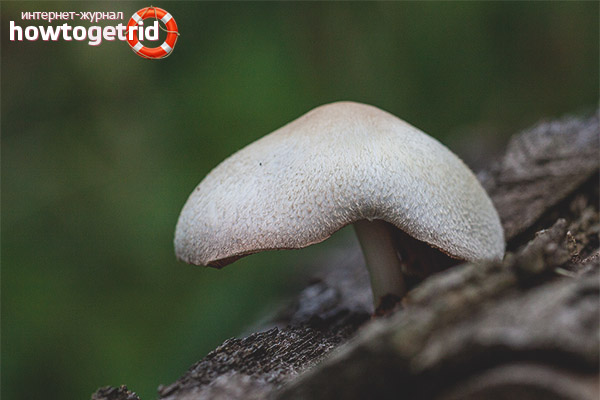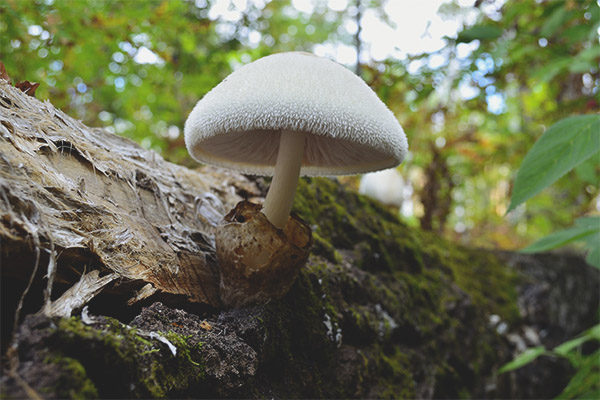The content of the article
Such a mushroom growing on wood, as silky volvariella, belongs to the mushrooms of the pluteev family. Received its name due to the characteristic cover, called Volvo. Also, this representative of the mushroom kingdom is known to many lovers of quiet hunting called Volvariella Bombicins. In fact, this agaric is one of the most beautiful among all species growing on wood. I would like to draw attention to the fact that the representatives of this species are quite rare fungi, classified as conditionally edible.
Description
The cap of the mushroom is bell-shaped, reaching a diameter of 180-200 mm. At the beginning of growth, the lamellar body of the cap is pinkish; in the process of development, it acquires a brownish color.Volvareella leg is rather long, at the base it has some thickening. The spores of the fungus are elliptical in shape pink.
Due to its peculiar appearance, which implies a unique color, as well as the characteristic fibrous structure of the surface of the fruit body of the cap, Volvariela is quite difficult to confuse with other types of fungi. According to many experienced mushroom pickers, this type of mushroom is quite suitable for food after boiling sufficiently long (the broth in which the mushrooms were boiled is sure to merge).
Spread
As mentioned above, Volvariella Bombicin is a rather rare type of mushroom, so mushroom pickers do not often collect it. The main place of growth of this species is mixed forests, as well as natural parks and protected areas that are quite large in size. Volvarella for its growth often chooses the wood of weakened deciduous trees, for example: willows, poplars, maples. The most active time of fruiting of this species of representatives of the mushroom kingdom is the summer season - from mid-July to the last days of August.
Some species of volvariella can be grown artificially, which allows a person engaged in the cultivation of this species to collect a fairly solid harvest of these tasty and rare mushrooms.
Development features
The beginning of the development of this type of mushroom begins with the growth stage of the “egg”. In fact, in this form, it is born, enclosed in a common bedspread. If the mushroom is divided into two parts, then inside you can see a kind of mushroom embryo. After the egg ripens, a mushroom appears from it. Note that at the beginning of growth, the cap of the fruit body of the volvariella has a bell-shaped form, after some time it straightens out; nevertheless, the leg of the specimen remains still wrapped in the remains of the cover.
The old mushroom, in contrast to young specimens, has a less attractive appearance, the surface of the cap becomes wrinkled, and the coloring of the fungus also disappears.
Similarities with other species
Due to its unique color of the fruit body, this type of mushroom as Volvariela is almost not similar to any other representative of the mushroom kingdom. Another characteristic feature of this species is the fibrous structure of the fruit body and a peculiar appearance.
Is it possible to eat?

Volvarella - although it belongs to conditionally edible species, however, most of the mushroom pickers who met and collected this species, consider it quite edible. The main condition for the preparation of this kind of plate fungus is the obligatory primary heat treatment, which implies boiling of fruit bodies. The broth obtained after boiling mushrooms merges.
Growing up
As stated above, Bombicine is an edible mushroom; nevertheless, its taste cannot be considered exceptional, especially in comparison with the majority of so-called “delicacy” mushrooms.Nevertheless, there are quite a few people involved in the artificial cultivation of mushrooms of this family, which helps them to get a good harvest every season. The most popular mushroom among all species of this family is the volvarella, cultivated by growing on straw and wood waste.
Related species
Most often, this type of Volvarell grows not only on wood, but also on the soil surface. In the forest often this type of mushroom is almost impossible to find. Often, representatives of this species of Volvarell can be found in the forest belt nearfields, on compost heaps, personal plots, kitchen gardens. Fruiting season from mid-summer and until autumn. The fungus grows singly or in small groups.
Video: volvariella silky (Volvariella bombycina)











To send